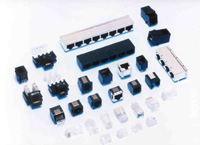 Photo ©1998 AMP INC.
Photo ©1998 AMP INC.Cartridge brass, a copper alloy containing about 30% zinc by weight, is easy to produce and is often cost effective because zinc generally costs less than copper. This most popular brass has attractive properties for terminals, springs, switches, contacts, and other connector components. It is also the most widely available copper alloy in the strip form required for stamping connector components.
Cartridge brass, as its name implies, was and still is used for ammunition cartridges. But it's used for numerous electrical applications such as switch and outlet boxes. There are at least sixteen different brasses, with zinc content ranging from 5% to 39%. Of these, the alloys containing 5, 15, and 30% zinc are the most popular for electronic applications.
The reason for the popularity of the brasses is not just their relatively low cost. They possess an excellent combination of strength, ductility, and conductivity. Extra spring temper cartridge brass can exceed 90 ksi 0.2% offset yield strength and can thus provide quite respectable contact forces, albeit with limited formability.
If the 28% IACS of cartridge brass isn't enough, it's easy to trade off strength in increments, and reach all the way to 56% IACS at 5% zinc. But if it is desirable to optimize strength and formability in the brass family, it may be necessary to use cartridge brass .
Cartridge brass has desirable mechanical and physical properties in addition to a long history as an economical copper alloy strip metal product. But either during the design stage, or perhaps later when increased demands are placed on the contact, terminal, switch, etc., the properties of cartridge brass may be inadequate. If it is possible to increase the temper while retaining enough formability to make the part, then cartridge brass may still suffice. For example, if hard temper cartridge brass is currently specified, just changing to spring temper will afford a 20% increase in contact force. But if cartridge brass is still too limited in the contact force it can provide, then phosphor bronze, described in the topic titled "Phosphor Bronze," may be a solution.
